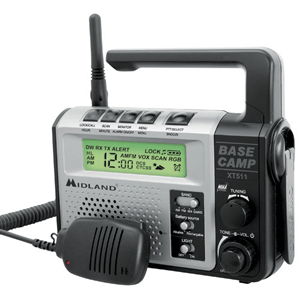Midland XT511 Base Camp Two Way Radio: Difference between revisions
No edit summary |
No edit summary |
||
| Line 4: | Line 4: | ||
The XT511 also features a flashlight, digital clock with alarm, an AM/FM radio, two-way transceiver and a NOAA weather alert radio. It supports 22 FRS and GMRS channels with 121 sub-audible tone squelch (CTCSS and DCS) codes per channel. Hands-free (VOX) mode is supported and a corded speaker microphone is included. A USB connector is also provided that allows you to charge your USB enabled devices such as a mobile phone. | The XT511 also features a flashlight, digital clock with alarm, an AM/FM radio, two-way transceiver and a NOAA weather alert radio. It supports 22 FRS and GMRS channels with 121 sub-audible tone squelch (CTCSS and DCS) codes per channel. Hands-free (VOX) mode is supported and a corded speaker microphone is included. A USB connector is also provided that allows you to charge your USB enabled devices such as a mobile phone. | ||
== Review == | |||
Having the ability to turn a crank for power is something that makes this a true emergency radio. I tested this having the unit gone completely dead with the rechargeable batteries installed. I was able to crank fewer than 10 times and make a transmission to announce my position. Transmitting consumes more power than monitoring or listening to broadcast radio, so this is better than expected for manually generated crank power. | |||
There is no manual squelch for the transceiver. Sometimes weak signals from your party can be missed because the hard coded squelch cuts the transmission out. Another feature lacking in this model is the ability to have a received transmission on your set channel cut in over the broadcast radio, such as some of 2-meter walkie-talkies do. I want to listen to music but not miss a transmission from a family member using a handheld trying to reach me at "base camp." | |||
Midland, please add two valuable features missing from this model: | |||
# Ability to listen to broadcast radio while monitoring one of the 22 FRS/GMRS channels. It should cut in when a transmission is received. | |||
# Ability to adjust the squelch level on the transceiver. | |||
Revision as of 22:20, 18 June 2015
The Midland Base Camp XT511 is a FRS/GMRS two way radio with emergency crank power. The Base Camp XT511 can also operate on battery power (included rechargeable battery or 4 "AA"). The rechargeable battery can be charged using the AC/DC adapters, or by turning the Dynamo crank.
The XT511 also features a flashlight, digital clock with alarm, an AM/FM radio, two-way transceiver and a NOAA weather alert radio. It supports 22 FRS and GMRS channels with 121 sub-audible tone squelch (CTCSS and DCS) codes per channel. Hands-free (VOX) mode is supported and a corded speaker microphone is included. A USB connector is also provided that allows you to charge your USB enabled devices such as a mobile phone.
Review
Having the ability to turn a crank for power is something that makes this a true emergency radio. I tested this having the unit gone completely dead with the rechargeable batteries installed. I was able to crank fewer than 10 times and make a transmission to announce my position. Transmitting consumes more power than monitoring or listening to broadcast radio, so this is better than expected for manually generated crank power.
There is no manual squelch for the transceiver. Sometimes weak signals from your party can be missed because the hard coded squelch cuts the transmission out. Another feature lacking in this model is the ability to have a received transmission on your set channel cut in over the broadcast radio, such as some of 2-meter walkie-talkies do. I want to listen to music but not miss a transmission from a family member using a handheld trying to reach me at "base camp."
Midland, please add two valuable features missing from this model:
- Ability to listen to broadcast radio while monitoring one of the 22 FRS/GMRS channels. It should cut in when a transmission is received.
- Ability to adjust the squelch level on the transceiver.
